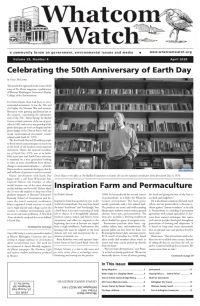by Peter Heffelfinger
As predicted by climate change models for the Northwest, our recent winter season arrived later in the autumn, and was highlighted by heavier, more sustained rainfall. We had relatively mild temperatures overall and only one serious snowfall, which melted after a few days. Rain accumulation records were set, and the dark days seemed to go on and on.
There was one anomaly early in the season: a day of continuous thunder, with the dark clouds, which usually move on to the east, staying put overhead and rumbling for hours. Thunder and lightening activity of any kind is rare in our coastal maritime area.
These rolling booms, however, were as if the storm gods were holding a non-stop bowling tournament overhead. Shades of Rumpelstiltskin falling into a deep sleep, dreaming of drinking and playing 10 pins in the sky with the Dutch elves of the Catskills.
I recently drove to Seattle and back in one day. The weather up here and in the city was overcast with a few sunbreaks. But each time I drove through the convergence zones near Everett, I met extremely heavy rainstorms that reminded me of the sudden, but short-lived downpours that occur back East, which we used to call “goose drown-ders.” The entire day, ending with a spectacular sunset framed by black clouds, seemed a microcosm of the whole winter season: mild at the start and finish, but with unusually intense storms concentrated in the middle.
In spite of the changes in the season, my backyard collection of hellebores were in flower in February as usual, with the over-wintering Anna’s hummingbirds darting from flower to flower as soon as the buds opened. Later on in March, as I was burning brush for several days, I noticed a resident hummer circling close to the edge of the bonfire and chirping, as if in a low-elevation version of the usual springtime vertical nesting and territory aerobatics.
Then I caught sight of a pair, linked in a mating flight, just at ground level, fluttering amidst the low branches of the Himalayan honeysuckle, a small ball of florescent feathers and buzzing wings. At the other end of the avian spectrum, I expect soon to hear the local bald eagles that perch in our tall firs, screeching and tumbling together much higher in the sky, with talons interlocked.
Garlic Duties
Active vegetable gardening in the winter has been limited to light maintenance. Following the usual advice for allium bulbs, I apply fertilizer to my garlic and shallot beds in February/March to give them a boost when soil nutrients are locked up by the cold. This year I am trying blood meal, a concentrated source of nitrogen, instead of the all-purpose organic mixture for most vegetables I have used in the past.
My garlic heads, all hard-neck varieties, are usually of a good size; but I have been growing them in rotation for seven-plus years around a single, large plot, and they may need some nutritional help. My shallots, a recent addition to my plantings, have not been as quite as impressive as those of my trusty farmers’ market vendor. So, if we shall see it makes any difference.
As well, I made sure the raised beds of garlic and shallots out on the Skagit Flats were well-trenched to handle the heavy rains, especially given the low-lying, clay soil. Having the luxury of off-season time, I spent an afternoon carefully ridding the beds of the nascent weeds already sprouting through the light layer of commercial mulch.
Weed early so that the entire root wads come out of the wet soil easily. Not so easy later on when the clay is rock-hard and the weeds are beginning to flower. Hopefully, the garlic bulbs below ground will appreciate the lack of competition for nutrients and space.
The Pantry
Late winter and early spring is also time to tote up what’s been over-wintered in storage. The winter squashes on shelves in the cool, unheated back room are beginning to soften, especially the large Cinderella squash and the Sugar Pie pumpkins; the hard-shelled spaghetti squashes are impervious to surface mold, though getting lighter as they dry out.
I have one golden acorn to get to before it succumbs. I have removed several generations of sprouts from the boxed potatoes, to keep them from getting soft. The collection of heirloom apples, picked from a neighbor’s orchard and immediately put into a storage fridge kept at 38-40 degrees Fahrenheit, have been slowly softening all winter. Still edible, if a bit mushy, and good for cooking. Some of the early fall apple varieties needed to be used before rotting out, but the hard russet-skinned heirlooms, often with pink flesh, hold their texture.
The garlic heads, stored in brown paper bags, are still hard but will start to soften and sprout soon. The Russian Reds, with thick, tight skins on the cloves, last the longest; the Music, Deja Vue, and Korean Red varieties do soften sooner, but generally hold up well until March or early April.
To keep a steady supply of fresh garlic available until June, when the fresh scapes will be available, I peel the last of the stored cloves before they get too soft and process them into a smooth pulp for short-term freezing in jars. Not quite the tang of fresh garlic, but good for soup and sauces. Garlic jam.
It is rewarding to store some home-grown vegetables or fruit without any processing other than a consistent temperature. A feeling of comfort comes with having a full larder, which also includes a stocked freezer of tomato sauce, corn, peppers, green beans, cauliflower, prepared ratatouille, and berries. Reminds one of Badger in “The Wind in the Willows,” with his snug burrow stocked with lots of good things to nibble on all through the dark days of winter.
Last Vegetables Standing
Outside in the vegetable garden, the small, but hardy Valentine Purple Broccolis matured in late February and into March, impervious to frost and snow. The rows of leeks also easily survived the winter, shielded by their outer sheaths that soften in the cold and wet, but protect the gleaming inner stalks.
As well, the January King cabbages are heading up into loose bundles, ideal for quickly sauteeing with apple slices or for adding to soup. The collards and all the various kales are putting up their first seed-heads, small buds that are easily snapped off for stir-fries, along with the tiny flowerets of the Purple Sprouting Broccoli that will soon start to appear. Brassicas are year-round.
The best thing about a productive winter garden is that you don’t have to feel so rushed into getting started with spring planting. It’s usually too wet to plow anyway. The pea starts you put in super-early will just sit there, waiting for warmer soil, while later-sown peas will catch up and be the same size once true springtime rolls in. And if the climate change model holds up, spring will arrive early, just like last year .
___________________________
Peter Heffelfinger, a Washington State University master gardener, has gardened organically on Fidalgo Island and the Skagit Flats for over 40 years. He has given workshops in year-round gardening for Transition Fidalgo/Eat Your Yard, Christianson’s Nursery, and at the Washington State University County Extension Service. He is a Salish Sea Steward, working on the invasive green crab survey.





























